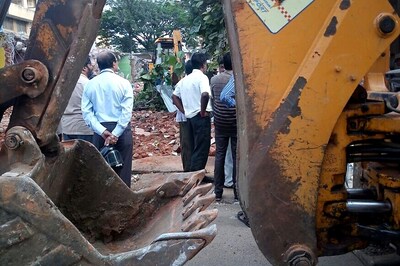
views
There seem to very few things that are certainties in life. One is day after night. The other being taxes. We can perhaps add the robustness of the Indian smartphone market to that. Even as most product lines struggled last year to register traction and sales as the COVID-19 pandemic wreaked havoc in more ways than one, smartphone sales rebounded quickly enough. We had reported that in Q3 2020, a record 54.3 million units were shipped in the quarter which ended September, making India the only market in the top three in the world to register positive growth, according to numbers from the IDC Quarterly Mobile Tracker.
A similar growth was seen in the pre-owned smartphone market in India, soon after the first wave of the coronavirus and the subsequent lockdown situation. News18 spoke with Nakul Kumar, Co-Founder and COO of Cashify, India’s leading re-commerce marketplace for buying and selling used smartphones and other electronics, at a time when the company is releasing the annual “User Behaviour whitepaper” for the pre-owned smartphone market. Kumar tells us that in the used smartphone space, Xiaomi leads the way followed by Apple and Samsung. He also says that data didn’t indicate any impact on the sales or popularity of Xiaomi phones, even as the anti-China sentiment peaked for a period last year. Cashify has recently raised $15 million in a new financing round and tells us that the company plans to aggressively expand with offline presence and also add more gadget categories for pre-owned products. Edited excerpts here.
Q: Last year, laptops got a massive boost due to work from home. Did smartphones also see a similar wave of sales, or did users hold on to the phones they had?
Besides work from home, daily activities like distance learning, grocery shopping, medicine shopping etc. have come to depend on technology. Such new demands have changed the dependency of people on smartphones too. Since most of these activities can be carried out on smartphones at a lower cost, there has been a hike in smartphone sales as well. The first two quarters saw dipped smartphone sales, with 4% and (-)50.6% YoY growth respectively. In Q3, though, consumers rushed to the market with more aspiration to upgrade their smartphones than ever. The 2020 Q3 smartphone shipments in India were at 53 million units which made it the highest-ever shipment in a quarter. Xiaomi topped the chart as the most sold smartphone brand by its users. In the pre-owned market, Mi stood as the number one selling brand with a 26% share followed by Apple (20%) and Samsung (16%) in third position, followed by Motorola (6%), Vivo (6%) and Oppo (5%).
Q: Were there any interesting buying trends or demographics that were noticed on the Cashify platform, as everyone bore the brunt of the COVID pandemic?
A major migration from offline to online took place last year. Shopping, working and studying was done digitally. With easing restrictions people did step out. For those who still preferred offline, over 17 Cashify Stores were launched in the second half of 2020 all over India. We recorded a YoY growth of over 40% in the mobile buyback segment in 2020. There was a mixed demographic responsible for this boost. On one hand, there were working professionals selling their old phones and upgrading to better models for work and on the other, there were parents of school-goers upgrading to devices to support distance learning.
Q: Were there any specific devices or price bands that saw most traction?
Compared to 2019, nearly all brands registered growth in sales in Q3. The mid-tier segment (Rs10,000 – Rs20,000) recorded the highest growth. Xiaomi tops the chart as the most sold smartphone brand by its users followed by Apple and Samsung. Among Indian cities, Delhi (23%), Mumbai(13%),Bangalore (11%), and Hyderabad(7%) are the top four for sales of pre-owned smartphones.
Q: Tell us a bit more about the findings of the Cashify User Behaviour whitepaper and how this compares with the previous edition.
Interesting insights emerged from the whitepaper. Despite the nationwide lockdowns, the 2020 Q3 smartphone shipments in India were at 53 million units which made it the highest-ever shipment in a quarter. Xiaomi was the most sold smartphone brand by its users. In the pre-owned market, Mi stood as the number one selling brand with a 26% share followed by Apple (20%) and Samsung (16%) in the third position, followed by Motorola (6%), Vivo (6%) and Oppo (5%).
The consumers’ choice of online retailers reveals how even offline-centric brands like Vivo and Oppo have been forced to scale up their online presence. People sold their used mobiles the most in Delhi (23%), Mumbai(13%), Bangalore (11%), and Hyderabad(7%). Satellite towns such as Ghaziabad, Faridabad, Ahmedabad and Lucknow have also shown robust growth and secured top spots in the upcoming city category.
Q: Have buying trends changed?
A majority of Indians preferred buying smartphones over laptops, 84% of them upgraded their smartphone within 14-18 months of purchase. No-cost EMI option and replacement warranty were the top criterions for purchase. As many as 50% buyers chose affordability as a primary reason for buying refurbished gadget from online reseller instead of a brand new one. Smartphones around the age of 3 years got sold the most by users. Nearly 62% smartphone issues are screen-related and battery issues come next with about 21%. Around 80% of the males sold their smartphones while only 20% of the females sold their smartphones in 2020. The number of smartphone repairs is the highest in Delhi which is over 35% in the entire country.
Also, the coronavirus (COVID-19) outbreak has digitally transformed our places of work and education. The companies that were resistant to the concept of a distributed workforce were forced to allow work from home so that work could still go on while taking precautions to stop the virus spread.
Q: Are more people seeing pre-owned phones as a viable option to a new phone, particularly in this period of financial uncertainty?
Of course. Preowned, refurbished phones specifically, come at much lower prices than their new counterparts. Since these devices are renewed, they also ensure the same quality that the brand new devices have. Hence, they are becoming a better and pocket-friendly option for people across the country.
Q: Is it because of the comparative savings compared to a similar new phone, or the chance to go a step up in terms of features and performance?
Both. Refurbished phones cost less than newly manufactured phones. They also offer higher specs at a lower price and hence fulfil the aspirational value of a new device. In other words, they pack affordability and a solid upgrade into one.
Q: Which phones are the most popular in the preowned phones space? What holds more weightage of a preowned phone buyer—brand or the price tag and therefore perceived value?
Since we have seen higher demand of Redmi and Apple, we can safely say that we are catering to a mixed user base here. Some care more about the price point while others are more concerned about the perceived value of the device they invest in. The top selling refurbished mobile models according to the Cashify data are the Xiaomi Redmi Note 5 Pro, Apple iPhone 6, Redmi Note 4, Apple iPhone 6s, Redmi 9A and iPhone 7.
Q: Has the anti-China sentiment which was quite vocal for a significant duration in 2020, impact what phones were being preferred more? Is that change in preferences still continuing, or are users focusing less on the country-of-origin aspect?
Last year turned the tables for all of us in an unprecedented manner. Some well-known, mega brands had to shut shop in India, while some dormant ones got to see the light of day again. Lockdowns and the Indo-China conflict had an impact on the smartphone industry as well. As sentiments soured between the neighbouring countries, the interdependent smartphone markets faced new challenges. Vocal for local or Atmanirbhar Bharat was a campaign undertaken by the government to enable Indian manufacturers to gain dominance across industries. Micromax, a brand which was almost forgotten, made a comeback with its sub-brand “In”. Lava, the indigenous brand aims to own at least 5% of the smartphone market in 2021. The local OEM has re-entered the market with its customized range of smartphones called “MyZ”. Similarly, Karbonn is looking to launch new smartphones in 2021.
The sentiments did hurt the sales of Xiaomi for one quarter in the brand new segment, for refurbished phones, we didn’t see much of an impact in the sales of the same.
Q: Do you believe the semiconductor shortage is going to have an impact in the long run, and could that lead to an increase in prices in the preowned phones market?
There is a worldwide shortage of semiconductors currently. Exacerbated by the coronavirus pandemic, the heavily Asia-dependent chip market is seeing a dip in supply as the demand from smartphone to PC to automobile makers rises. If the cost of semiconductors goes up, the price of mobile phones will go up as a chain effect. This will impact the pre-owned smartphone market by hiking their prices as well.
Q: Are there certain parts of the country that see more traction on the Cashify platform, and how is the demand met for these regions?
A major chunk of our user base comes from the metro cities New Delhi (23%), Mumbai (13%), Bengaluru (11%), Hyderabad (7%) and Gurugram (5%). This doesn’t mean that smaller cities lag far behind. Our presence in the cities like Kanpur, Lucknow, Thane, Faridabad, Surat, Chandigarh among many others, make use a preferred go-to place for mobile users.
Q: Does one region or city prefer a certain type of phone or is any city more price sensitive than others, for instance?
About 18% iPhone users are from Delhi while Samsung enjoys its highest number of users from Delhi, about 14%. Next on the chart are Bengaluru and Hyderabad. The top user base of OnePlus is based out of Delhi, as 14% users are from the city while Mumbai and Bengaluru come next . Oppo, in India, has the highest user base from the city of Delhi, around 14%. Next on the list are Bengaluru and Mumbai.
Q: What are Cashify’s expansion plans for the next few quarters? Is it a case of tapping pent up demand or consolidate with a market that is picking up again?
We have expansion plans for online and offline. Today, there are over 60 brick and mortar Cashify Stores present across the country including 8 franchise stores in India. The target is to go from 60 to 150 stores over the next year and half. We also plan to offer omni-category services to users. So far, people can avail mobile phone, smart watch, laptop, tablet etc. related services and products. What lies in the pipeline is Cashify’s target to include maximum categories in the upcoming days and fortify our presence in the retail world to cater to the rising digital requirements of customers.
Read all the Latest News, Breaking News and Coronavirus News here.




















Comments
0 comment